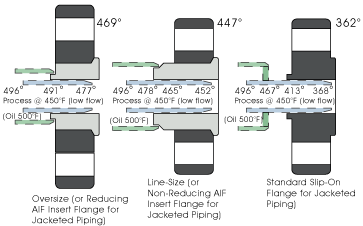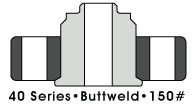Insert flanges for jacketed piping are one of the few flanges on the market made exclusively for jacketed piping applications. Jacketed piping is when a system has one pipe inside of another. It is needed when there is a process pipe (core pipe) of fluid that needs to be heated or cooled with a jacketed fluid or gas. American Insert Flange (AIF’s) insert flanges for jacketed piping solve many problems that can arise when fabricating this type of pipe.
First, insert flanges for jacketed piping have a two-piece make-up consisting of an insert and a flange. This basic configuration is similar to a lap joint and stub-end flange, allowing for easy alignment of the bolting holes between mating flanges. As you can see by clicking on our cut sheets, either from the side-bar or below, the core and jacket pipe only weld to the insert portion, so the flange is always free to rotate. AIF’s flanges also provide specific places to weld the core and jacket pipe. Our flanges are custom made per your core and jacket pipe schedules to allow for easy unions of the pipes and insert. This can also be beneficial since only the insert has to be made out of the core pipe material, the flange can be made out of carbon steel or a lesser alloy. This can result in cost savings when high-priced specialty alloys are being used for your process pipe (such as B-3, C-276, and alloy 20, etc.)
The graphic below shows the thermodynamic benefits of jacketed insert flanges. This study was conducted by one of the top jacketed piping fabricators in the United States, Controls Southeast, Inc., to show the heat transfer benefits by using insert flanges.

The insert flange for jacketed piping allows the designer to efficiently bring the jacket fluid up against the back of the flange assembly in either the oversize or line-size styles, minimizing the heat transfer loss as well as assembly time.
When referring to insert flanges for jacketed piping, AIF specifies the (flange size x core pipe size and schedule x jacket size and schedule)(For example, a 2″ x 1″-sch10 x 2″-sch10 would have a 2″ flange and the insert would be made to fit a 1″ schedule 10 core pipe and a 2″ schedule 10 jacketed pipe. The style, either buttweld core or slip-on core, need to be specified. Finally, the material of the insert and flange need to be specified. Usually this consists of a 316/316L or 304/304L insert with a carbon steel flange. However, AIF custom makes our inserts and flanges to any machinable material. We commonly make inserts out of everything from carbon steel to C-276 and we on occasion make our flange rings out of stainless or specialty steels. For more information or a quotation about insert flanges for jacketed piping, please check out our FAQs Page, call us at (856) 629-4555, or email us at sales@AmericanInsertFlange.com.
Click on one of the pictures below to download the corresponding dimensional data cut sheet! (ASME CONFORMING mean that the flange thickness is engineered via AIF calculations performed by our engineer to fully comply with all pressure temperature/pressure vessel ratings for ASME B16.5. CONVENTIONAL or standard flange thicknesses means that these insert flanges use the dimension for whatever a standard flange would be. CONVENTIONAL insert flanges have been used the longest in the industry, however, ASME CONFORMING are more popular today due to ASME code being a growing expectation in piping systems.)
ASME CONFORMING (RATED)
OVERSIZE (REDUCING style where the flange size is the same as the jacket pipe; example 2″x1″x2″ where 2″ is the flange size x 1″ core pipe size x 2″ jacket pipe size – the flange size reduces to the core pipe size )
 |
 |
 |
 |
LINE-SIZE (NON-REDUCING style where the flange size is the same as the core pipe; example 1″x1″x2″ where 1″ is the flange size x 1″ core pipe size x 2″ jacket pipe size – the flange size does not reduce to the core pipe size since they are the same, so non-reducing is the terminology)
 |
 |
 |
 |
CONVENTIONAL (STANDARD FLANGE THICKNESS)
OVERSIZE (REDUCING style where the flange size is the same as the jacket pipe; example 2″x1″x2″ where 2″ is the flange size x 1″ core pipe size x 2″ jacket pipe size- the flange size reduces to the core pipe size) (The “S” as in “S10 Series” stands for standard flange thickness or conventional series)
 |
 |
 |
 |
LINE-SIZE (NON-REDUCING style where the flange size is the same as the core pipe; example 1″x1″x2″ where 1″ is the flange size x 1″ core pipe size x 2″ jacket pipe size- the flange size does not reduce to the core pipe size since they are the same, so non-reducing is the terminology) (The “S” as in “S30 Series” stands for standard flange thickness or conventional series)
 |
 |
 |
 |
